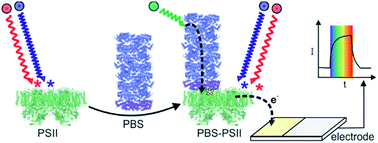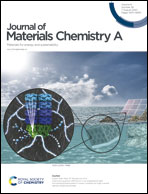Improved quantum efficiency in an engineered light harvesting/photosystem II super-complex for high current density biophotoanodes†
Abstract
Photosystem II (PSII) is the only enzyme that catalyzes light-induced water oxidation, the basis for its application as a biophotoanode in various bio-photovoltaics and photo-bioelectrochemical cells. However, the absorption spectrum of PSII limits the quantum efficiency in the range of visible light, due to a gap in the green absorption region of chlorophylls (500–600 nm). To overcome this limitation, we have stabilized the interaction between PSII and Phycobilisomes (PBSs) – the cyanobacterial light harvesting complex, in vitro. The PBS of three different cyanobacteria (Acaryochloris marina, Am, Mastigocladus laminosus, ML, and Synechocystis sp. PCC 6803, Syn) are analyzed for their ability to transfer energy to Thermosynechococcus elongatus (Te) PSII by fluorescence spill-over and photo-current action spectra. Integration of the PBS–PSII super-complexes within an Os-complex-modified hydrogel on macro-porous indium tin oxide electrodes (MP-ITO) resulted in notably improved, wavelength dependent, incident photon-to-electron conversion efficiencies (IPCE). IPCE values in the green gap were doubled from 3% to 6% compared to PSII electrodes without PBS and a maximum IPCE up to 10.9% at 670 nm was achieved.

- This article is part of the themed collection: Journal of Materials Chemistry A HOT Papers


 Please wait while we load your content...
Please wait while we load your content...